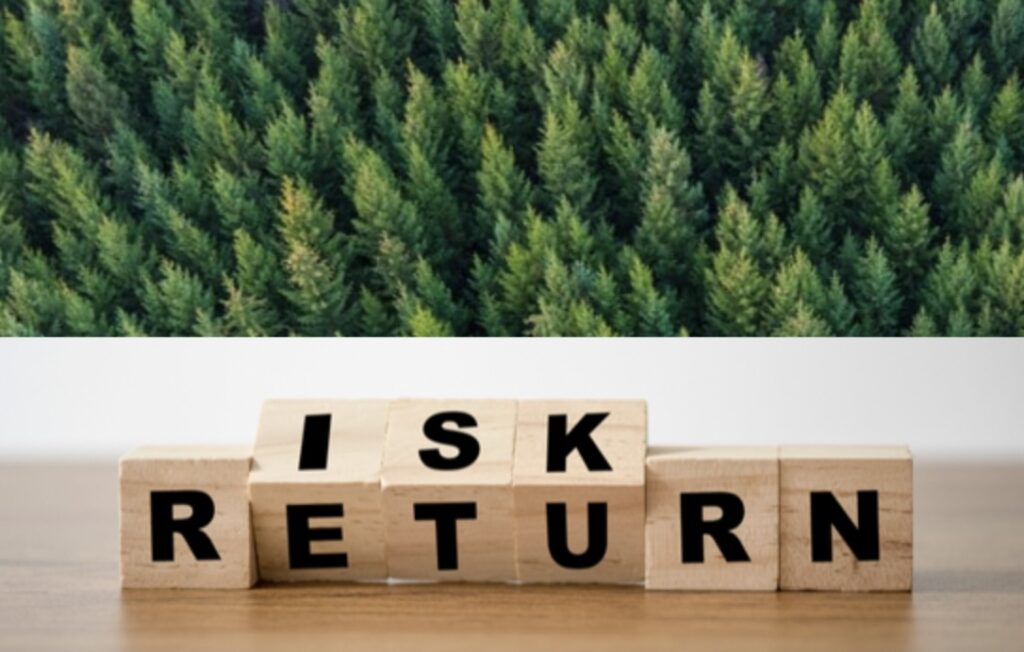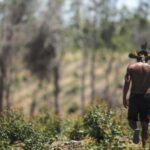Understanding various financial and market risks are among the first elements in an investor’s risk assessment when designing a new forest investment strategy
Risk is a common language spoken among investors the world over. Whether a VC investor, public equities, bonds – whatever the investment vehicle of choice, understanding risk is of paramount importance for any investment strategy or vehicle.
I was inspired (and not shocked) by FMO’s summary of their recent LATAM event, co-led by the Mobilising Finance for Forests initiative (MFF), the Restoration Seed Capital Facility (RSCF), The Nature Conservancy (TNC) and The Sustainable Trade Initiative (IDH) to bring together 55 industry leaders in the forestry and sustainable land use sectors. The primary outcome of discussions – more education is needed on both the investor and entrepreneurial ends of the sector.
Starting with a summary of the event’s findings on entrepreneurial and investor education needs, required to facilitate private capital flows into the sector, I’ll dig into one big piece of this puzzle – risk, more specifically – Financial risk.

Mobilizing finance for the Amazon (and the rest of LATAM, Africa and Asia)
Building investment savviness in Entrepreneurs
On the entrepreneurial side, the LATAM event found that business-mindedness is lacking. Of the cases presented, the event found that project developers often lack capacity in such aspects as business development, commercial relations with investors and financial modelling. Important for investors are the entrepreneur’s ability to operate amidst tenure uncertainty, building credible revenue models, and designing impact measurement systems. I suspect that the commercial mindset and skillset is also missing from the subset of developers that have traditionally been working on a donor or NGO support model – where such business capacity is not as important as the ability to implement the restoration activities.
What I have also seen is experienced entrepreneurs, fearless trail blazers with the gumption to embark on new sustainable forest and land-use ventures may have the business acumen to engage in investor conversations, but they don’t have the forestry-specific expertise behind them to build the solid forest investment case to put investor’s minds at ease and build the investor-entrepreneur trust that the MFF event noted is lacking.
Educating Investors on the Characteristics of Forest Investment
The pressure for investors to invest in the green transition is rising (this article explains why). Despite the climate, nature, social, and circular bioeconomy credentials of the forest asset class, forestry as a nature-based, climate solution is not landing with most investors. Why? They don’t understand it.
“Scalability happens when the risk is understood by the market” – Fund manager at MFF event
Investors misunderstand facts on the ground and often perceive risks to be higher than they are. What results is a lack of investment activity in improved forest land use, where opportunities for returns, and the plethora of benefits listed above are lost.
“Without further education, in 50 years’ time nothing will have changed” – Managing Director, non-profit
On that note, let’s introduce risk in forest investment, as an early piece in the investor’s forest investment education. And because it’s a big topic, in this article we’ll focus on the issues around Financial risk.
Understanding Risk in Forest Investment
Reflecting on past blog posts, risk is a topic I cover in nearly every article that I write. Though I notice that few articles have been dedicated to the subject. See the following articles for topical risk deep dives:
Don’t Let Forest Investment Risks Fall Between Chairs | The ForestLink
Reducing Risk in REDD+ | The ForestLink
The main risks of forest carbon strategies in the tropics, and how to mitigate them | The ForestLink
The first article in the above list provides an overview of the various categories of risk you would assess. In this article, we’re going back to basics on financial risk. We will take it from the starting point of considerations that an investor will need to make when designing a forest investment strategy.
Understanding Financial Risk in the context of Forest Investment
Capital Structure
Within a forest business’ capital structure, equity is generally preferred, as high debt loads are not healthy for the long-time horizon associated with the asset class. This is different for more mature assets, where forest harvests are already in (or nearing) cashflow generation.
Not all investment partners are created equal. This is a no-brainer, but if you are new to investing in forests, you probably don’t want to be investing alongside other shareholders that are also new to the asset class. Having at least one investment partner (preferably with a majority position or decision-making authority) that is experienced with the asset class will be an invaluable intangible asset for your investment.
Interest rates and Inflation
Top of mind for every investor these days are the macro financial concerns of high interest rates and inflation. An analysis by Timberland Investment Resources that looked at forest investment in the US amidst a higher interest rate environment concludes that forest investments remain attractive during such economic times due to the asset class’:
- Decline in annual volatility of returns,
- Low correlation to many other asset classes, and
- Ability to hedge against inflation risks.
Stepping aside from the asset class performance as a whole and looking at factors linked to the particulars of an asset in the strategy, one would want to consider the stage of the forest business. The investment case for an early-stage plantation might suffer if exposed to several years of high interest rates and inflation, being subject to many years of ongoing operating costs prior to generating cashflow. It would be important to understand on the forest business’ balance sheet which items would be particularly susceptible to these unfavorable conditions and stress test them. When considering more mature assets, you will want to understand the flexibility of harvesting – is the asset legally required to harvest a certain volume of wood every year – or can you under/over harvest depending on the business’ cashflow needs that might be affected by interest rates and inflation.
Currency Risk
Currency risk can be navigated as it is for other asset classes through hedging, clever holding structures, flexibility in exit (to not force divestment when exchange rates are poor) or investing in jurisdictions that share your own currency. Special considerations for forestry are related to the domestic/export dynamics of targeted wood markets and seeking diversification where risks are observed. If the currency of the investment jurisdiction is strong relative to export markets, it’s time to access domestic markets, and vice versa. Having flexibility in the ability to switch between domestic and export markets would also lower currency risk. Note that some jurisdictions have regulations against raw log exports to support local processing industries – so if your asset is only selling logs, and not processing logs into timber and other wood products, you might suffer from such legislation.
Market Risk
Market risk for forest investments has to do with market volatility (prices, supply and demand, related policies, etc.) of the forest products and other secondary markets your forest asset’s value is driven by. The International Woodland Company (IWC) and Wood Resources International (WRI) produce regular timber market updates for the world’s primary wood markets. The International Tropical Timber Organization publishes timber market (ITTO) updates for tropical wood products. There are also regionally specific timber market assessments, where you can get more detailed information for specific jurisdictions.
A recent study by Chudy et al in 2020, found that excluding the price of land and biological growth (a topic for another risk deep-dive), timber prices were the most influential variables that impacted IRRs across global timberland investments. When talking prices, volatility is a real issue, as has been experienced in particular for structural lumber, over the past couple of years. This is not a reason to invest or not into forest assets, it is a reason to ensure you have flexibility in your harvest timing – so you can hold off on harvesting when prices are low, and pick up pace when prices are high. Keep in mind, this will be the strategy of others in the industry, so there will be supply chain issues also to consider. In the case of downward price fluctuations in a certain product type, you would want to make sure that this is not signaling a shift in consumer preference to substitute the product with something else.
On the demand side of the equation, forest products demand are expected to increase as policy makers and the general public look for substitutions for high emission materials (like concrete, steel, plastic and even fossil fuels). There are several wood products that a forest can deliver – from structural lumber, through manufactured wood products (like plywood), pulp and paper, and bioenergy being the most traditional. Further when talking about the surge in demand for climate and now nature values – forests also can deliver on these, and the demand for ecosystem services markets is still in its early days and growing.
Integrating Macro-trends into your Financial Risk Assessment for Forest Investment
There is a lot to unpack here, so it’s not a surprise that investors scramble to understand the financial risks associated with a forest investment. However, I suggest that most of these are softened by the long-time horizon of forest investments if you have flexibility in when you harvest and when you divest. Some overarching considerations to dig into to ensure that you minimize your financial risk when developing a forest investment strategy are:
- Capital Structure – Equity is preferred to debt in most cases (debt can be suitable for value-add investments into processing for mature forest assets) and ensuring you have at least one investment partner with forest investment experience will go along way in steering your asset in the right direction.
- Interest Rates, Inflation, Currency – Though interest rates and inflation are a bit of a global pandemic currently, they won’t always be, and forestry is long-term. Currency fluctuations are obviously regionally specific – so if you are investing in a currency different than your own, consider the ability to shift between domestic and export markets.
- Markets – To get a feel for price volatility, understand the supply and demand dynamics for different wood products relevant to your target geography, and diversify.
- Stage of business – stress testing operational costs (and prices for that matter) for forest businesses that are a way off from cashflow generation is important to understand the viability of the asset.
- Integration of ecosystem services markets – integrating assets where carbon and nature markets can be accessed adds to diversification, resilience in general of the asset, and is a value addition to boost returns.
If you are new to forest investment and would like to discuss this, as a wider piece of the forest investment concept you are mulling over, please reach out – in as little as a one hour conversation, you will leave our engagement with concrete actions to move your forest investment idea to a launched strategy.
Did you like this article? Sign up now for the ForestLink’s newsletter, where you’ll receive technical advice, reflections, and best-practice guidance to support you with your forest-linked investment strategy or business straight to your inbox.





